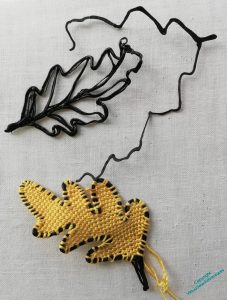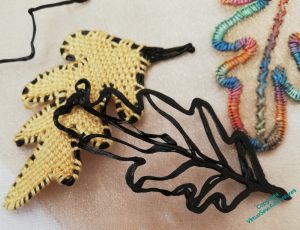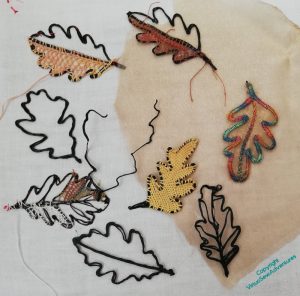Oak Leaf Wreath Testing
I mentioned that I had more experiments to perform on the leaves, and several people hastened to tell me that I should be sure to Test To Destruction. They are right, of course, and having plenty of samples in the pack that Caroline Hack sent me to play with, I was able to do just that.
One of them, I pulled and twisted, trying to snap the plastic. That turned out to be much harder than I had expected it to be, considering how flimsy it felt when I was nervously working needlelace over the leaf shapes.
Then I fished out the heat gun that I still have left over from some experiments with paper crafting, covered a drinking glass with a bit of greaseproof paper, and tried to soften the plastic so it would match the curve of the glass. The plastic certainly moved, but not in a very controlled fashion, so I tried again, this time using one of my needlelace experiments. It was still an undercontrolled shift, but it did produce the sort of twisted look of a drying leaf. I tried hard to photograph it so that the curves really showed!
I worked a series of experimental needlelace sections in some of the other pieces. Knotted stitches in slubby linen (really don’t do this – friction becomes a real problem!), cloth stitch in silk (the yellow that in due course was melted and twisted) and a variety of others.
I think, in the end, the difficulty of covering the borders, and the slippy plastic which makes it hard to keep the threads in place, mean that this won’t be the best way to do the oak leaf wreath. I may still have thoughts about this as I begin to plan, and in particular, I need first of all to work out how big my oak leaves need to be in order to be in proportion with the mirror.
You can now watch Episode 67 of SlowTV Stitchery, which is entirely concerned with my battles with Swirl Stitch!




your oak leaves look lovely apart, as you say from the rather distracting visible plastic which does seem to negate the whole idea doesn’t it? I have noticed that you can buy coloured silk covered wire and wondered if that would work, except for the difficulty in getting the shape right, which is much easier with the extruded plastic. I suspect you’ve considered it already since it’s sold by Thistle Threads.
Love the changed sky in your priory needlepoint, it looks much better, that block of white cloud on the left was distracting and your random clouds have worked really well. I like the swirl stitch too, which is very evocative of waves though I do wonder if it could be adapted to slightly smaller scale. Admittedly the foreground, in perspective terms, would be bigger, but the two rows slightly dominate at the moment don’t they? Lots more fun to be had, hopefully not too much unpicking 🙂
The leaves must have been an interesting project. The plastic shapes were worth exploring in different ways, even if they haven’t given you what you want. Finding what doesn’t work is often as useful as finding what does.
Like Kathy, I thought the scale of the choppy water was a bit out of keeping with the rest of the picture. It also seemed very dark and rather saturated. Maybe adding one or two threads of a medium-light Payne’s grey to every section would hold the shades together and break up the big, flat blocks, while also giving some natural light on the water?
I await the next installment with interest!
Experimenting is always informative even when it doesn’t provide the solution you are looking for. I enjoy your experiments and your process almost as much as your finished projects.
Really nice.
As ever, a fascinating look into your thought processes. If nothing else, you’re working out what doesn’t work, the importance of which is sometimes overlooked!
Oak leaf is the most beautiful leaf I like to do eco printing. We don’t have in Hong Kong. How I love to see your work with it.